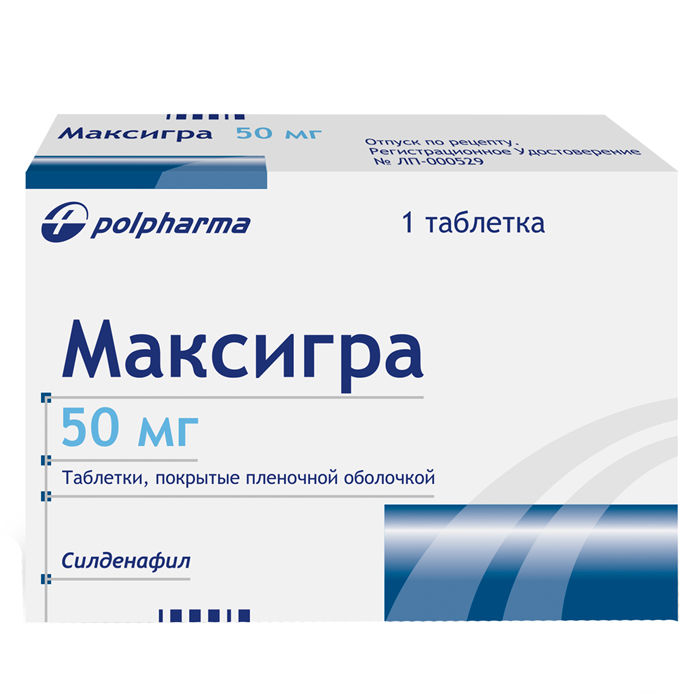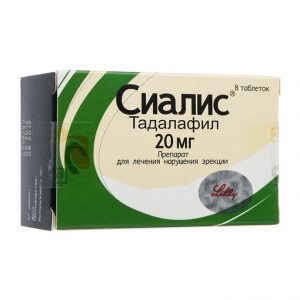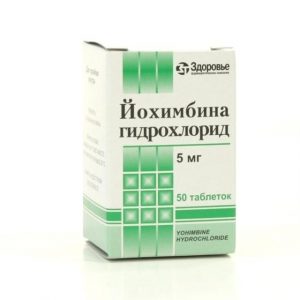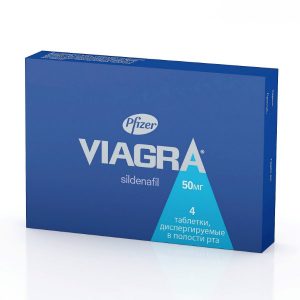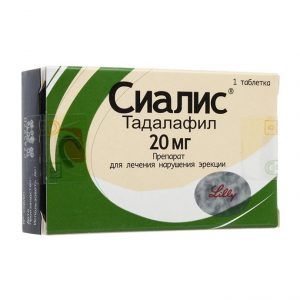Description
Latin name
Maxigra
Release form
Tablets.
Packaging
In the package 1 pc. 50 mg
Indications
Treatment of erectile dysfunction characterized by the inability to achieve or maintain an erection of the penis, to achieve or maintain an erection of the penis sufficient for a satisfactory intercourse.
The drug is effective only with sexual stimulation.
Contraindications
Hypersensitivity to sildenafil or to any other component of the drug.
Use in patients receiving continuously or intermittently nitric oxide donors, organic nitrates or nitrites in any form, since sildenafil enhances the hypotensive effect of nitrates (see section “Interaction with other drugs”).
The safety and effectiveness of sildenafil when used together with other treatments for erectile dysfunction have not been studied, so the use of such combinations is not recommended (see section “Special instructions”).
According to the registered indication, sildenafil is not intended for use in children under 18 years of age.
According to the registered indication, sildenafil is not intended for use in women.
With caution
Anatomical deformation of the penis (including during angulation, cavernous fibrosis, or Peyronie’s disease) (see section “Special instructions”).
Diseases predisposing to the development of priapism (sickle cell anemia, multiple myeloma, leukemia, thrombocytopenia) (see. Special Instructions).
Patients with a history of anterior ischemic optic neuropathy of an optic nerve of a non-inflammatory genesis.
Diseases accompanied by bleeding.
An exacerbation of peptic ulcer of the stomach and duodenum.
Hereditary retinitis pigmentosa (see Special Instructions)
Heart failure, unstable angina, myocardial infarction, stroke or life-threatening arrhythmias, arterial hypertension (blood pressure> 170/100 mm Hg. ) or hypotension (blood pressure <90/50 mm Hg) (see section "Special instructions"). Concomitant use of alpha-blockers. Use during pregnancy and lactation Sildenafil is not intended for use in women. Composition of One tablet contains: active substance: sildenafil citrate 70.24 mg or 140.48 mg (equivalent to sildenafil) 50.00 mg or 100.00 mg, respectively, excipients: mannitol, crospid (25 times crodid) ), silicon dioxide colloid, corn starch, magnesium stearate, sodium lauryl sulfate, shell composition: hypromellose (15 mPas), macrogol6000, 1 titanium dioxide. Dosage and administration Inside, about 1 hour before the planned sexual activity. The maximum recommended frequency of use is once a day. Single dose for adults – 50 mg 1 time per day. Given the effectiveness and tolerability, the dose can be increased to 100 mg or reduced to 25 mg. The maximum single dose is 100 mg. When taking sildenafil together with fatty foods, the onset of its action may be delayed compared with fasting. Use in elderly patients In elderly patients, dose adjustment is not required. Use in patients with impaired renal function In renal failure of mild to moderate severity (CC 30-80 ml / min), dose adjustment is not required, in case of severe renal failure (CC <30 ml / min) the dose of sildenafil should be reduced to 25 mg Given its efficacy and tolerability, the dose may be increased to 50 mg and 100 mg. Use in patients with impaired liver function In cases of impaired liver function, the dose should be reduced to 25 mg. Given its efficacy and tolerability, the dose may be increased to 50 mg and 100 mg. Use in patients receiving other medications With the exception of ritonavir, with which co-administration of sildenafil is not recommended, in patients receiving concomitant treatment with inhibitors of the isoenzyme CYP3A4, the initial dose should be 25 mg. To minimize the possibility of developing orthostatic hypotension in patients taking alpha-blockers, sildenafil treatment should be started after hemodynamic stabilization in these patients. In addition, the appropriateness of prescribing sildenafil in an initial dose of 25 mg should be considered. Side effects The frequency of side effects is given in accordance with the following classification: very often ( 1/10), often ( 1/100, <1/10), infrequently ( 1/1000, <1/100), rarely ( 1/10000, <1/1000), very rarely (<1/10000), the frequency is unknown (according to the available data, it was not possible to establish the frequency of occurrence). Disorders of the immune system: infrequently – a hypersensitivity reaction. Disorders from the nervous system: very often – headache often – dizziness infrequently – hypesthesia, drowsiness rarely – stroke, fainting frequency is unknown – intracerebral hemorrhage, transient ischemic attack, convulsions, including recurrent. Disorders of the organ of vision: often – impaired vision, changes in color perception infrequently – conjunctivitis, violation of lacrimation, pain in the eyes, photophobia, photopsy, redness of the eyes / injection of sclera, change in brightness of light perception, frequency is unknown – anterior ischemic optic neuropathy of the non-inflammatory genesis (NAION), retinal vascular occlusion, visual field defects. Hearing disorders and labyrinth disorders: infrequently – vertigo, tinnitus rarely – deafness. Disorders from the cardiovascular system: often – flushing of blood to the face infrequently – palpitations, tachycardia rarely – arterial hypertension, arterial hypotension, myocardial infarction, atrial fibrillation frequency unknown – ventricular arrhythmia, unstable angina, sudden cardiac death. Disorders of the respiratory system, chest and mediastinal organs: often nasal congestion rarely – nosebleeds. Disorders of the gastrointestinal tract: often – dyspepsia infrequently – vomiting, nausea, dry mouth. Disorders from the liver and biliary tract: frequency unknown – hepatotoxicity (liver damage and increased levels of transaminases). Disorders of the skin and subcutaneous tissues: infrequently – skin rash, unknown frequency – Stevens-Johnson syndrome, toxic epidermal necrolysis. Disorders of the musculoskeletal and connective tissue: infrequently – myalgia. Disorders from the genitals and mammary gland: infrequently – hematospermia, bleeding from the penis, frequency unknown – priapism, prolonged erection. General disorders and disorders at the injection site: rarely – chest pain, fatigue. Drug Interaction Effect of Other Drugs on Sildenafil Metabolism Sildenafil metabolism occurs mainly in the liver under the action of CYP3A4 (main pathway) and CYP2C9 (minor pathway) isozymers, so the clitoris may interfere with these enzymes. When co-administered with CYP3A4 isoenzyme inhibitors (such as ketoconazole, erythromycin, cimetidine), a decrease in sildenafil clearance was observed. Single dose of sildenafil at a dose of 100 mg together with erythromycin, a specific inhibitor of the CYP3A4 isoenzyme (at a dose of 500 mg 2 times a day for 5 days), under equilibrium erythromycin concentration, sildenafil AUC is increased by 182%. Cimetidine (800 mg), a cytochrome P450 inhibitor and nonspecific CYP3A4 isoenzyme inhibitor, when co-administered with sildenafil (50 mg) in healthy volunteers caused a 56% increase in plasma sildenafil concentration. The concomitant use of sildenafil (100 mg single dose) and the ritonavir HIV protease inhibitor (500 mg twice daily), a potent cytochrome P450 inhibitor, resulted in an increase in Cmaxil of 4% in equilibrium concentrations of ritonavir in blood times) and sildenafil AUC by 1000% (11-fold). After 24 hours, the concentration of sildenafil in the blood plasma was approximately 200 ng / ml compared to about 5 ng / ml when using one sildenafil. The concomitant use of sildenafil (100 mg once) and the saquinavir HIV protease inhibitor, a CYP3A4 isoenzyme inhibitor, at equilibrium concentrations (at 1200 mg 3 times daily) resulted in an increase of Cmaxildenafil Cmaxilenafil by 140%, 210%. Sildenafil had no effect on the pharmacokinetics of saquinavir. More potent CYP3A4 isoenzyme inhibitors, such as ketoconazole and itraconazole, may cause more pronounced changes in the pharmacokinetics of sildenafil. CYP2C9 inhibitors (such as tolbutamide, warfarin, phenytoin), CYP2D6 inhibitors (eg, selective serotonin reuptake inhibitors, tricyclic antidepressants), thiazides, and thiazide-like diuretics, “petelbereters” Calcium antagonists and inducers of CYP450 metabolism (eg rifampicin, barbiturates) have no effect on the pharmacokinetics of sildenafil. Single administration of an antacid (magnesium hydroxide / aluminum hydroxide) does not affect the bioavailability of sildenafil. In healthy male volunteers, concurrent administration of azithromycin (500 mg per day for 3 days) has no effect on AUC, Cmax, Tmax, withdrawal rate constant, and T sildenafil or its major circulating metabolite. Grapefruit juice is a weak inhibitor of CYP3A4 isoenzyme metabolism in the gastrointestinal wall and can cause a moderate increase in sildenafil plasma concentrations. Effects of sildenafil on other drugs Sildenafil is a weak inhibitor of cytochrome P450 isoenzymes – 1A2, 2C9, 2C19, 2D6, 2E1 and 3A4 (IK50150 mol). Sildenafil is unlikely to affect the clearance of substrates of these isoenzymes. Sildenafil enhances the antihypertensive effect of nitrates, so its combined use with nitric oxide donors or nitrates in any form is contraindicated. In some sensitive patients receiving alpha-blockers, concomitant administration of sildenafil may lead to symptomatic hypotension. With concomitant administration of the alpha-blocker of doxazosin (4 mg and 8 mg) and sildenafil (25 mg, 50 mg and 100 mg) in patients with benign prostatic hyperplasia with stable hemodynamics, the mean additional decrease in systolic / diastolic blood pressure in the supine position was 7/7 mm Hg, 9/5 mm Hg and 8/4 mm Hg, respectively, and in standing position – 6/6 mm bw, 11/4 mm bw and 4/5 mm Hg, respectively. Rare cases of the development of symptomatic orthostatic hypotension in the form of dizziness (without fainting) have been reported in such patients. No significant interaction of sildenafil (50 mg) when co-administered with tolbutamide (250 mg) or warfarin (40 mg) metabolised by CYP2C9 was detected. Sildenafil (100 mg) had no effect on the pharmacokinetic parameters of steady-state HIV protease inhibitors, such as saquinavir and ritonavir, which are both CYP3A4 substrates. Sildenafil (50 mg) did not cause an additional increase in bleeding time caused by acetylsalicylic acid (150 mg). Sildenafil (50 mg) did not increase the antihypertensive effect of alcohol in healthy volunteers at a maximum blood alcohol concentration of 80 mg / dL on average. No signs of interaction of sildenafil (100 mg) with amlodipine were found in patients with hypertension. The average additional reduction in blood pressure in the supine position is: systolic – by 8 mm Hg, diastolic – by 7 mm Hg. The use of sildenafil in combination with antihypertensive drugs does not lead to additional side effects. Overdose With single doses up to 800 mg in studies in healthy volunteers, adverse events were comparable to those seen with lower doses of sildenafil, but their frequency and severity increased. The use of sildenafil at a dose of 200 mg did not lead to increased efficacy, but the incidence of adverse events (headache, “hot flashes” of blood to the face, dizziness, dyspepsia, nasal congestion, visual impairment) increased. Treatment: symptomatic. It is not displayed during hemodialysis. Storage conditions At a temperature not exceeding 30 ° C. Keep out of the reach of children. Expiration 4 years. Do not use the drug after the expiry date. Active ingredient Sildenafil pharmacy terms and conditions prescription dosage form dosage form tablets Polarma, Poland
